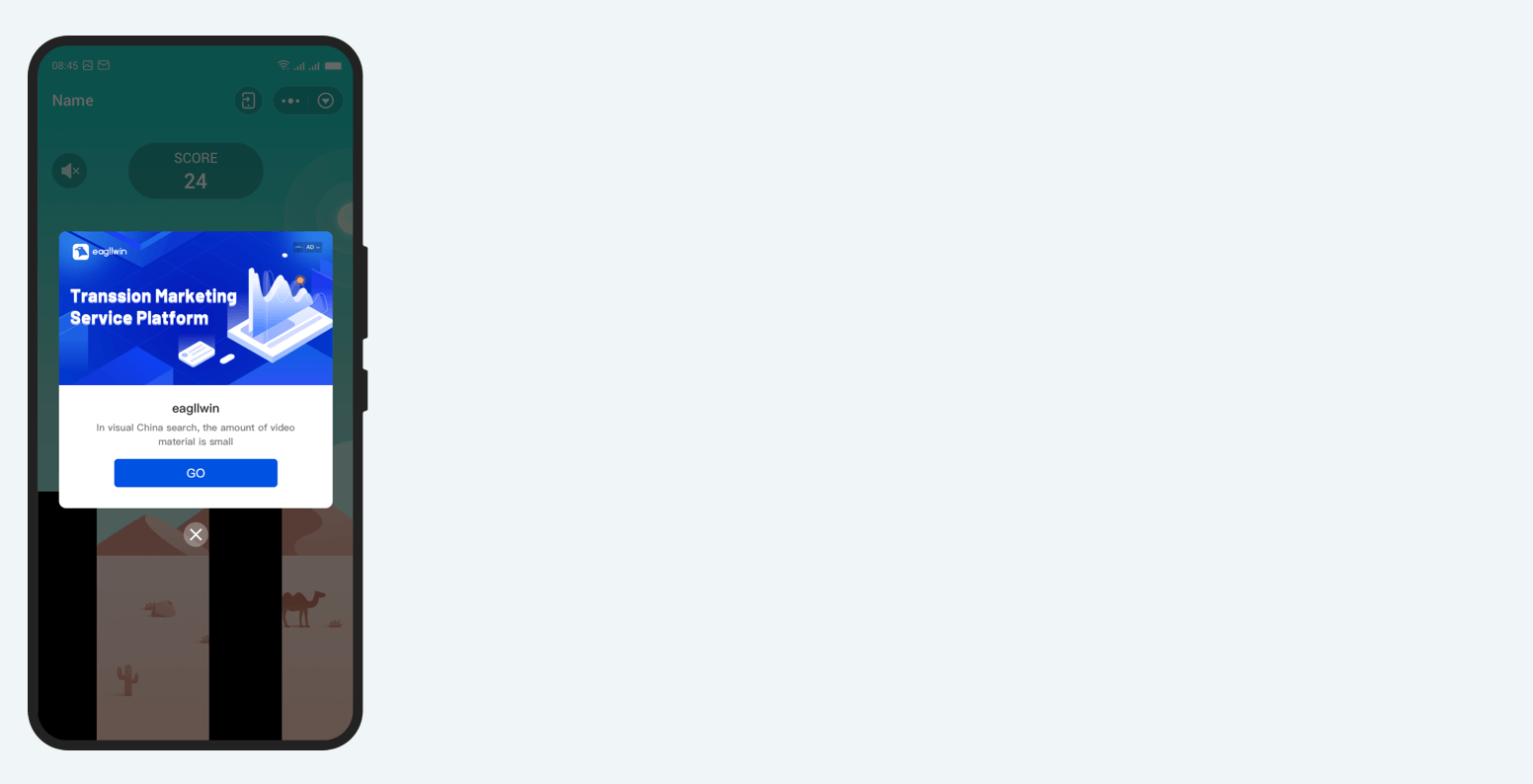Interstitial Ad Component
1. Recommendations for Usage Scenarios
The interstitial ad component is suitable for the following scenarios:

Tab switching
Show ads when switching from the home page to the store tab.
Show ads when switching back to the home page from the personal page tab.
Game round completion
Show ads at the end of each game round.
Show ads after completing a game level.
Video playback pauses
Show ads when a video stops playing.
Show ads when a video is paused.
Workflow completion
Show ads when completing a shopping and checkout process.
Show ads after sharing content.
Not recommended for showing small program interstitial ads in the following scenarios:
Do not insert ads when the user opens the small program.
Do not interrupt the user's complete operation process.
For example, do not insert ads during an immersive game process or a quick information flow pull-down refresh process.
2. API Documentation
Introduction
The interstitial ad component is composed of native image and text controls, and is the highest level component that covers regular components. Developers can call dlt.createInterstitialAd to create an interstitial ad component. Each time this method is called, a new instance is returned, which is only valid for the current page and cannot be used across pages.
Parameters
| Attribute | Type | Required | Description | Minimum Supported Version Number | SDK Minimum Supported Version |
|---|---|---|---|---|---|
| appId | string | Yes | Total application ID of the small program (obtained from the Hisavana Platform) | 2.9.0 | 2.2.0 |
| codeSeatId | string | Yes | Small program code seat ID (obtained from the Hisavana Platform) | 2.9.0 | 2.2.0 |
| codeSeatType | string | Yes | Small program ad type field (obtained from the Hisavana Platform) 1: native 2: banner 3: interstitial 4: splash screen 5: rewarded video (4 and 5 are currently not supported) | 2.9.0 | 2.2.0 |
Return Value
InterstitialAd
Ad Creation
The interstitial ad component is hidden by default, so it can be created in advance and the component can be initialized in advance. Developers can create an ad instance in the onLoad event callback of the small program page and repeat calling the ad instance in the lifecycle of the page.
// pages/index/index.js
Page({
onLoad() {
if (dlt.createInterstitialAd) {
const interstitialAd = dlt.createInterstitialAd({
codeSeatId: "xxxx",
appId: "xxx",
codeSeatType: "x",
});
interstitialAd.onLoad(() => {
console.log("onLoad event emit");
});
interstitialAd.onError((err) => {
console.log("onError event emit", err);
});
interstitialAd.onClose((res) => {
console.log("onClose event emit", res);
});
this.interstitialAd = interstitialAd;
}
},
});
Display/Hide
The interstitial ad component is hidden by default, and developers need to call interstitialAd.show to display it. If the ad fails to load or is triggered by rate limiting, the interstitialAd.show() method will return a rejected Promise, and developers can listen to the error message. The error code information table is shown below.
interstitialAd.show().catch((err) => {
console.error(err);
});
Users can actively close interstitial ads. Developers cannot control the hiding of interstitial ad components.
Ad Fetching Success and Failure
The interstitial ad component automatically fetches and updates ads. After the component is created, an ad will be fetched. After the user closes the ad, the next ad will be fetched.
If the ad is fetched successfully, the callback function registered through interstitialAd.onLoad will be executed, and the callback function does not have any passed parameters.
interstitialAd.onLoad(() => {
console.log("Interstitial ad loaded successfully");
});
If the ad fails to fetch, the callback function registered through interstitialAd.onError() will be executed, and the callback function's parameter is an object containing the error information.
interstitialAd.onError((err) => {
console.log(err);
});
Listen for the User to Close the Ad
If the ad is closed, the callback function registered through interstitialAd.onClose() will be executed, and the callback function does not have any passed parameters.
interstitialAd.onClose((res) => {
console.log("Interstitial ad closed");
});
Precautions
Multiple event callbacks such as interstitialAd.onLoad(), interstitialAd.onError(), and interstitialAd.onClose() will produce multiple event callbacks. It is recommended to listen once after the ad is created, or cancel the original listen event before reregistering it.
Error Code Information Table
If the interstitial ad fails to display, the InterstitialAd.show() method will return a rejected Promise, and the developer can get the error code and corresponding error message.
| Code | Exception | Reason |
|---|---|---|
| 2000 | Call exception | The current version does not support interstitial ads. |
| 2001 | Trigger frequency limit | Interstitial ads are not allowed to be displayed within a certain time after the small program is started |
| 2002 | Trigger frequency limit | The time interval between the last display time of the small program interstitial ad is insufficient, and the interstitial ad cannot be displayed. |
| 2003 | Trigger frequency limit | An interstitial ad is being displayed, and another interstitial ad cannot be displayed. |
| 2004 | Ad rendering failure | This error is not an exception handling made by the developer, or the ad rendering failed due to a switch of small program pages. |
| 2005 | Ad call exception | The interstitial ad instance cannot be called across pages. |
| 2006 | Ad call exception | The call failed due to the parameter not meeting the requirements. |
| 2007 | Ad call exception | The interstitial ad instance failed to fill. |